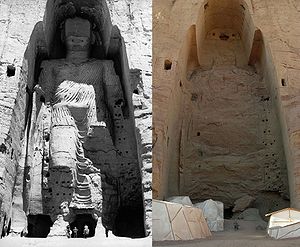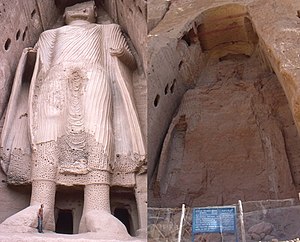Hindu and Buddhist heritage of Afghanistan




| History ofAfghanistan |
|---|
 |
| Timeline |
Communities of various religious and ethnic backgrounds have lived in the land of what is nowAfghanistan.Before theIslamic conquest,the south of theHindu Kushwas ruled by theZunbilandKabul Shahirulers. When theChinesetravellers (Faxian,Song Yun,Xuanzang,Wang-hiuon-tso, Huan-Tchao, and Wou-Kong) visited Afghanistan between 399 and 751 AD, they mentioned that Hinduism and Buddhism were practiced in different areas between theAmu Darya(Oxus River) in the north and theIndus Riverin the south.[1]The land was ruled by theKushansfollowed by theHephthalitesduring these visits. It is reported that the Hephthalites were fervent followers of the Hindu godSurya.[2]
The invading Muslim Arabs introducedIslamto a Zunbil king ofZamindawar(Helmand Province) in 653-4 AD. They took the same message toKabulbefore returning to their alreadyIslamizedcity ofZaranjin the west. It is unknown how many accepted the new religion, but the Shahi rulers remained non-Muslim until they lostKabulin 870 AD to theSaffaridMuslims of Zaranj. Later, theSamanidsfromBukharain the north extended their Islamic influence into the area. It is reported that Muslims and non-Muslims still lived side by side in Kabul before the arrival ofGhaznavidsfromGhazni.
"Kábul has acastlecelebrated for its strength, accessible only by one road. In it there areMusulmáns,and it has a town, in which are infidels fromHind."[3]
— Istakhri,921 AD
The first mention of aHinduin Afghanistan appears in the 982 ADḤudūd al-ʿĀlam,where it speaks of a king in "Ninhar" (Nangarhar), who shows a public display of conversion toIslam,even though he had over 30 wives, which are described as "Muslim,Afghan,and Hindu "wives.[4]These names were often used as geographical terms by the Arabs. For example,Hindu(orHindustani) has been historically used as ageographicalterm to describe someone who was native to the region known asIndia,andAfghanas someone who was native to a region calledBactria.
Archeology[edit]
| Location | Artifacts found | Other information |
|---|---|---|
| Hindu temple atKhair KhanehinKabul. | Marble statues ofSurya,the Hindu god ofsun.[5] | |
| Gardez | Statues ofDurgaMahishasuramardini.[5] | They show Hindu GoddessDurga,the consort ofShiva,slaying buffalo demonMahishasura. |
| Hindu Temple at Chaghan Saray in theKunar Valleyin eastern Afghanistan.[5] | Temple complex | |
| Tapa Skandar 31 km north of Kabul.[5] | Remains of settlement dating to the second half of the first millennium AD. Marble statue ofShivaand his wifeParvati.[5] | |
| Tapa Sadr nearGhazni.[5] | Statue of theParinivana Buddha(Buddha lying down at the end of his cycle of rebirths).[5] | 8th century AD |
| Gardez | Śāradā scriptengraved on a marble statue of an elephant deityGaneshbrought by theHinduShahis who occupied the Kabul Valley.[5] | 8th century AD |
| Nava ViharaBalkh | ||
| Airtam NearTermez | A stone slab with aBactrianinscription and a carved image ofShiva.[6] | |
| Tepe Sardar, Ghazni | Large Buddhist monastery complex[7] | The mainStupais surrounded by many miniature stupas and shrines, ornamented with clay bas reliefs. There were several colossal statues of theBuddha,included one seated and of the Buddha inNirvana.In one shrine which is in the Hindu style a clay sculpture of Durga slaying a buffalo-demon was found.[7] |
| Homay Qala in Ghazni | Buddhist Cave Complex at Homay Qalay.[8] | |
| Tepe Sardar Ghazni | Durgaclay - 10th Century.[9] | 10th Century AD.[9]Durga was popularised during the Shahi period as several images of this deity are found in Afghanistan.[10] |
| Various | Coins of the Shahi rulers ofPanjaband Afghanistan have been found.[11] | 650-1000 AD[12] These coins were issued from at least eight mint towns, which suggests a wider range for their circulation[11] |
| Buddhas of BamiyanBamyan Province Hazarajatregion |
Believed to be built in 507 AD, the larger in 554 AD. Destroyed in 2001 by theTaliban. | |
| Khair KhanaKabul[11] | Hindu Temple,[11]two marble statues ofShiva[11] | |
| Basawal | Basawal is the site of a Buddhist cave temple complex in eastern Afghanistan. The caves, 150 in all, are partly hewn out in two rows and arranged in seven groups, which presumably correspond to the seven monastic institutions of Buddhist times.[13] | |
| Buddhist cave complex at Homay Qala[14] |
Table of pre-Islamic dynasties of Afghanistan[edit]
| Dynasty | Period | Domain | |
|---|---|---|---|
| Hindu Shahis | Closing years of the 10th and the early 11th century.Jayapalawas defeated bySultanMahmud of Ghazni.[15]in 1013 Kabul's last Shahi ruler[16] |
|
Gandhara(eastern Afghanistan and northwesternPakistan) was overrun by SultanMahmud of Ghazni.[15](Kabul valley) |
| Zunbils | The Zunbils were finally deposed byYa'qub Saffariin 870 AD, founder of theSaffarid dynastyinZaranj.[18][19] | Zabulistan(southern Afghanistan).[19] |
Islamic conquest of Afghanistan[edit]
The region aroundHerat ProvincebecameIslamizedin 642 AD, during the end ofMuslim conquest of Persia.In 653-4 AD, GeneralAbdur Rahman bin Samaraarrived fromZaranjto theZunbilcapitalZamindawarwith an army of around 6,000 Arab Muslims. The General "broke off a hand of the idol and plucked out the rubies which were its eyes to persuade the Marzbān ofSīstānof the god's worthlessness. "[20]He explained to the worshippers of thesolar deity,"My intention was to show you that this idol can do neither any harm nor good."[2]The people of southern Afghanistan began acceptingIslamfrom this date onward. The Arabs then proceeded to Ghazni and Kabul to convert or conquer the BuddhistShahirulers. However, most historians claim that the rulers of Ghazni and Kabul remained non-Muslim. There is no information on the number of converts, although the Arabs unsuccessfully continued their missions of invading the land to spread Islam for the next 200 or so years. It was in 870 AD whenYa'qub ibn al-Layth al-Saffarfinally conquered Afghanistan by establishing Muslim governors throughout the provinces.
"Arab armies carrying the banner of Islam came out of the west to defeat theSasaniansin 642 AD and then they marched with confidence to the east. On the western periphery of theAfghanarea the princes of Herat andSeistangave way to rule by Arabgovernorsbut in the east, in the mountains, cities submitted only to rise in revolt and the hastily converted returned to their old beliefs once the armies passed. The harshness and avariciousness of Arab rule produced such unrest, however, that once the waning power of theCaliphatebecame apparent, native rulers once again established themselves independent. Among these the Saffarids of Seistan shone briefly in the Afghan area. The fanatic founder of this dynasty, the coppersmith's apprentice Yaqub ibn Layth Saffari, came forth from his capital at Zaranj in 870 AD and marched throughBost,Kandahar,Ghazni,Kabul,Bamyan,Balkhand Herat, conquering in the name of Islam. ".[21]
— Nancy Dupree,1971
By the 11th century, when theGhaznavidswere in power, the entire population of Afghanistan was practicing Islam, except theKafiristanregion (Nuristan Province) which became Muslim in the late 1800s.
See also[edit]
- Gandharan Buddhism
- Gandhāran Buddhist texts
- Ancient history of Afghanistan
- Pre-Islamic scripts in Afghanistan
- Buddhism in Afghanistan
- Hinduism in Afghanistan
- Buddhas of Bamiyan
- Kandahar Greek Edicts of Ashoka
- Kandahar Bilingual Rock Inscription
- Gandhara Kingdom
- Nava Vihara
- Zabulistan
- Decline of Buddhism in the Indian subcontinent
References[edit]
- ^"Chinese Travelers in Afghanistan".Abdul Hai Habibi.alamahabibi.com. 1969.Archivedfrom the original on December 24, 2018.RetrievedAugust 9,2012.
- ^ab"Amir Kror and His pAncestry".Abdul Hai Habibi.alamahabibi.com.Archivedfrom the original on October 19, 2014.RetrievedAugust 14,2012.
- ^"A.—The Hindu Kings of Kábul (p.3)".Sir H. M. Elliot.London:Packard Humanities Institute.1867–1877. Archived fromthe originalon July 26, 2013.RetrievedSeptember 18,2010.
- ^Vogelsang, Willem (2002).The Afghans.Wiley-Blackwell. p. 18.ISBN0-631-19841-5.Archivedfrom the original on 2023-02-04.Retrieved2012-08-16.
- ^abcdefghThe Afghans By Willem Vogelsang Page 184
- ^History of civilizations of Central Asia, Volume 3 By Boris Abramovich Litvinovskiĭ Page 427
- ^abHistory of civilizations of Central Asia, Volume 3 By Boris Abramovich Litvinovskiĭ Page 399
- ^"South Asian archaeology 1975: papers from the third International Conference Edited by Johanna Engelberta Lohuizen-De Leeuw Page 121 to 126".Archivedfrom the original on 2023-06-20.Retrieved2022-08-13.
- ^abHistory of Buddhism in Afghanistan By Sī. Esa Upāsaka, Kendrīya-Tibbatī-Ucca-Śikṣā-Saṃsthānam page XX
- ^History of Buddhism in Afghanistan By Sī. Esa Upāsaka, Kendrīya-Tibbatī-Ucca-Śikṣā-Saṃsthānam page 187
- ^abcdeEarly medieval Indian society: a study in feudalisation By R.S. Sharma page 130
- ^Early medieval Indian society: a study in feudalisation By R.S. Sharma Page 130
- ^Encyclopedia Iranica
- ^Leeuw, Johanna Engelberta Lohuizen-De (1979).South Asian Archaeology 1975: Papers from the Third International Conference of the Association of South Asian Archaeologists in Western Europe Held in Paris.BRILL. p. 119.ISBN978-90-04-05996-2.Archivedfrom the original on 2023-06-20.Retrieved2022-08-13.
- ^abThe races of Afghanistan Being a brief account of the principal nations inhabiting that country, by Henry Walter Bellow Asian Educational services, Page 73
- ^Pakistan and the emergence of Islamic militancy in Afghanistan By Rizwan Hussain page 17
- ^Encyclopaedia of Historiography By M.M. Rahman
- ^Medieval India Part 1 by Satish Chandra Page 17
- ^abExcavations at Kandahar 1974 & 1975 (Society for South Asian Studies Monograph) by Anthony McNicoll
- ^André Wink, "Al-Hind: The Making of the Indo-Islamic World", Brill 1990. p 120
- ^Dupree, Nancy(1971) "Sites in Perspective (Chapter 3)"An Historical Guide To AfghanistanAfghan Tourist Organization, Kabul,OCLC 241390Archived2009-09-05 at theWayback Machine
External links[edit]
- Professor Abdul Hai HabibiSee articleThe Cultural, Social And Intellectual State Of The People Of Afghanistan In The Era Just Before The Advent Of Islam by eminent Afghan historian Abdul Hai Habibi
- Shahi Coins in theStandard Catalog of World Coins 1901-2000 By Colin R. Bruce, Thomas Michael Page 35
- Afghan caves contain world's first oil paintings
- Buddhist Sites in Afghanistan and Central Asia
